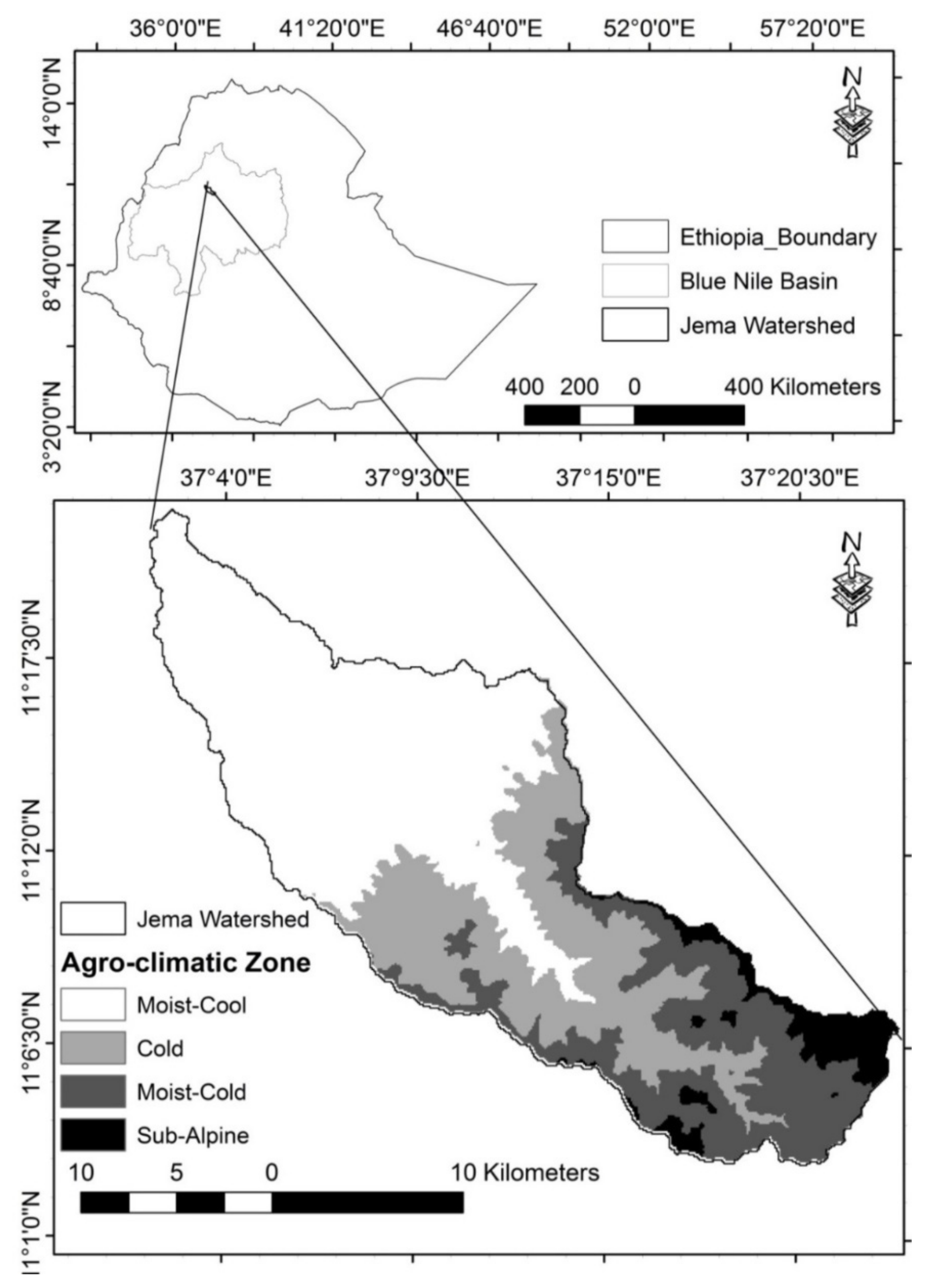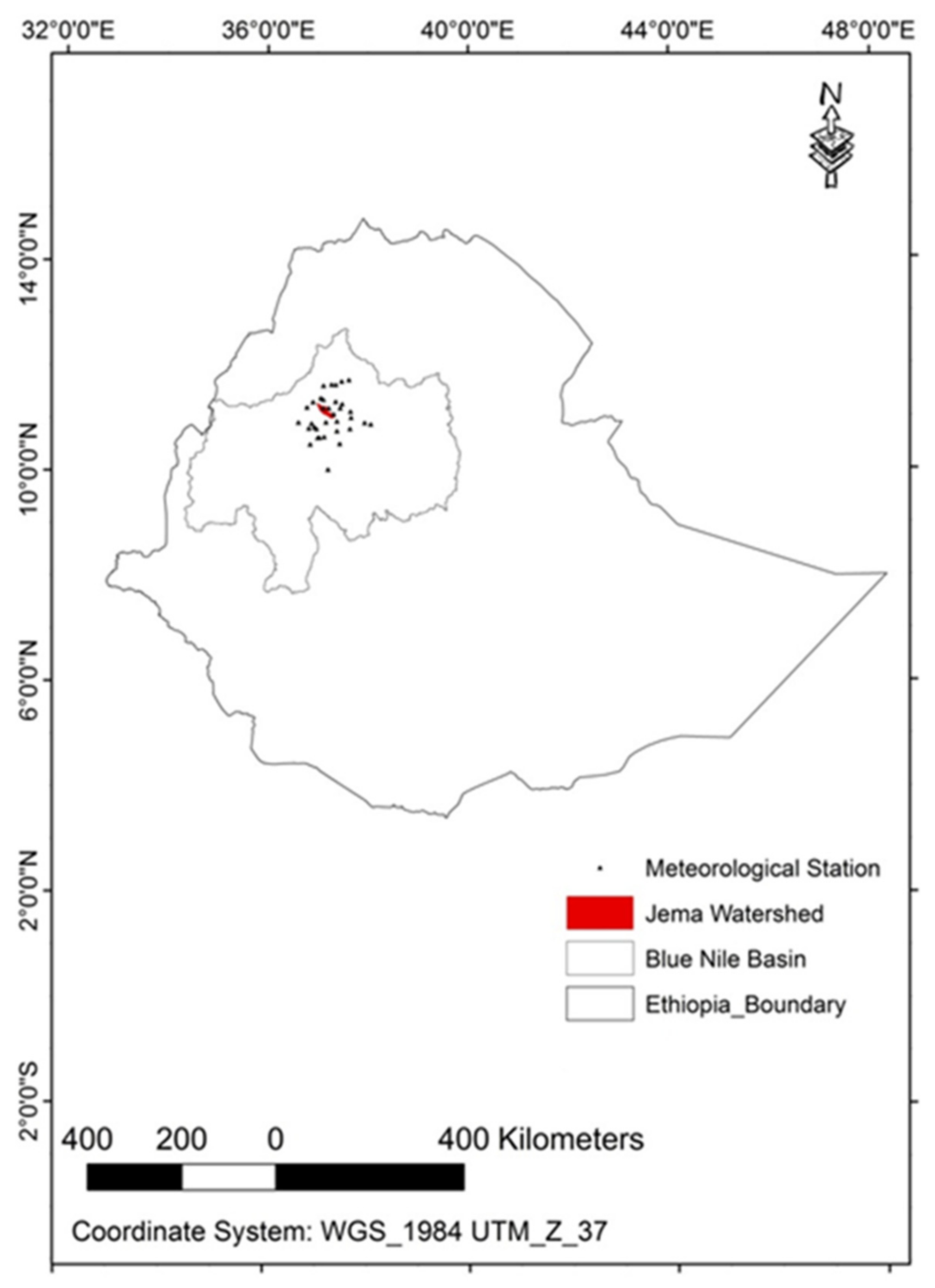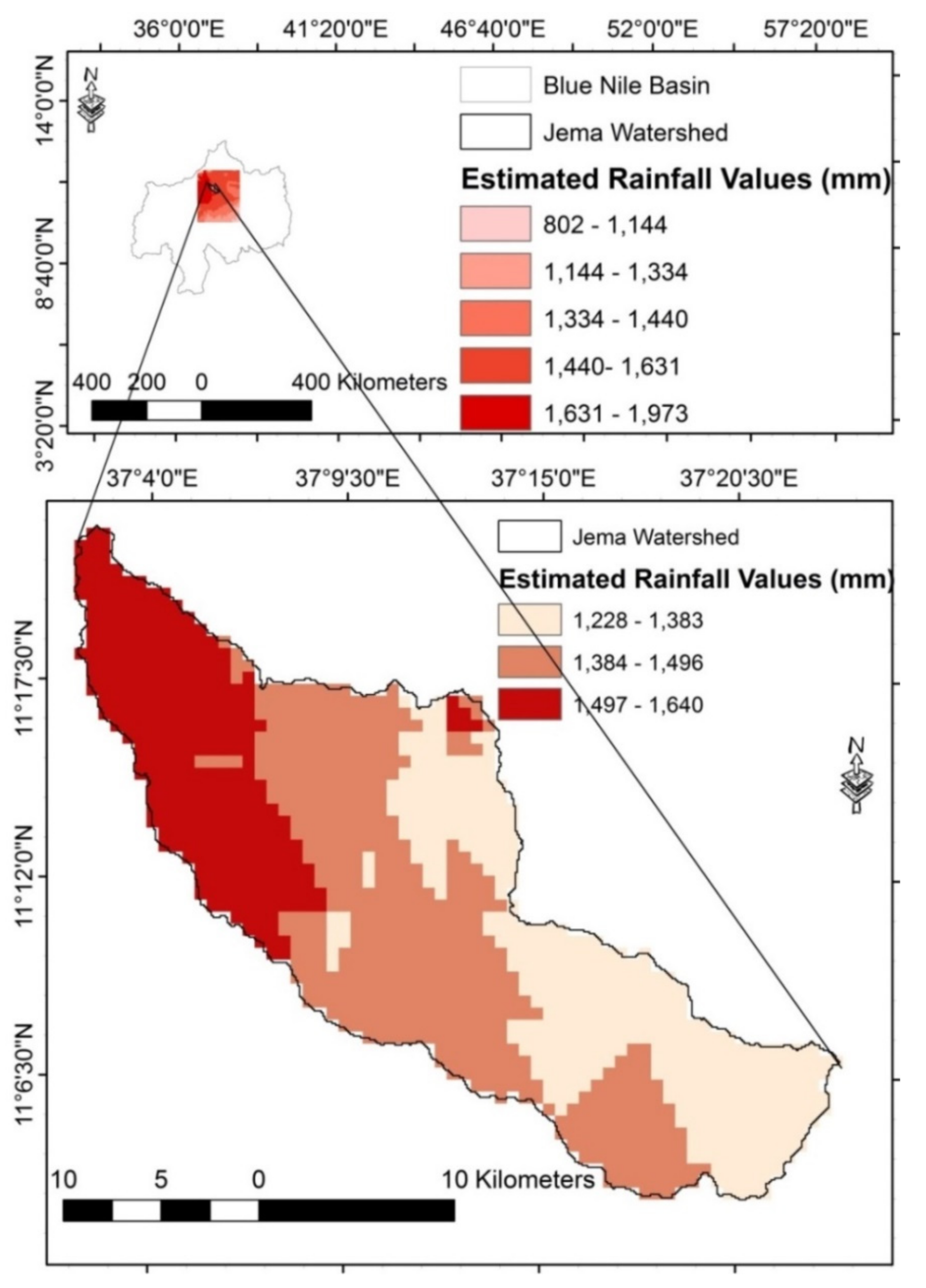Rainfall Variability across the Agro-Climatic Zones of a Tropical Highland: The Case of the Jema Watershed, Northwestern Ethiopia
Abstract
:1. Introduction
2. Materials and Methods
2.1. Description of the Study Area
2.2. Data Used
2.3. Indexing the Values of Indicators of Exposure to Climate Variability
3. Results and Discussion
3.1. Spatiotemporal Variability of Rainfall and Temperature
3.2. Degree of Exposure to Climate Variability among the ACZs
4. Conclusions and Recommendations
Author Contributions
Funding
Conflicts of Interest
References
- Food and Agriculture Organization (FAO). Land Evaluation towards a Revised Framework; Land and Water Discussion Paper; FAO: Rome, Italy, 2007; Volume 6. [Google Scholar]
- Mearns, R.; Norton, A. The Social Dimensions of Climate Change: Equity and Vulnerability in a Warming World; The World Bank: Washington, DC, USA, 2009. [Google Scholar]
- Field, C.B. (Ed.) Climate Change 2014–Impacts, Adaptation and Vulnerability: Regional Aspects; Cambridge University Press: Cambridge, UK, 2014. [Google Scholar]
- Solomon, S.; Qin, D.; Manning, M.; Averyt, K.; Marquis, M. (Eds.) Climate Change 2007-the Physical Science Basis: Working Group I Contribution to the Fourth Assessment Report of the IPCC; Cambridge University Press: Cambridge, UK, 2007. [Google Scholar]
- Tessema, I.; Simane, B. Vulnerability analysis of smallholder farmers to climate variability and change: An agro-ecological system-based approach in the Fincha’a sub-basin of the upper Blue Nile Basin of Ethiopia. Ecol. Process. 2019, 8, 5. [Google Scholar] [CrossRef]
- Deressa, T.T.; Hassan, R.M.; Ringler, C.; Alemu, T.; Yesuf, M. Determinants of farmers’ choice of adaptation methods to climate change in the Nile Basin of Ethiopia. Glob. Environ. Chang. 2009, 19, 248–255. [Google Scholar] [CrossRef]
- Simane, B.; Zaitchik, B.F.; Foltz, J.D. Agroecosystem specific climate vulnerability analysis: Application of the livelihood vulnerability index to a tropical highland region. Mitig. Adapt. Strateg. Glob. Chang. 2016, 21, 39–65. [Google Scholar] [CrossRef] [PubMed]
- Hurni, H.; Tato, K.; Zeleke, G. The implications of changes in population, land use, and land management for surface runoff in the upper Nile basin area of Ethiopia. Mt. Res. Dev. 2005, 25, 147–155. [Google Scholar] [CrossRef]
- Taye, M.; Simane, B.; Zaitchik, B.F.; Yihenew, G.S.; Setegn, S. Land Use Evaluation over the Jema Watershed, in the Upper Blue Nile River Basin, Northwestern Highlands of Ethiopia. Land 2019, 8, 50. [Google Scholar] [CrossRef]
- Arnell, N.W. Climate change and global water resources: SRES emissions and socio-economic scenarios. Glob. Environ. Chang. 2004, 1, 31–52. [Google Scholar] [CrossRef]
- Fekadu, K. Ethiopian seasonal rainfall variability and prediction using canonical correlation analysis (CCA). Earth Sci. 2015, 4, 112–119. [Google Scholar] [CrossRef]
- Bewket, W. Rainfall variability and crop production in Ethiopia: Case study in the Amhara region. In Proceedings of the 16th International Conference of Ethiopian Studies, Trondheim, Norway, 2–7 July 2007. [Google Scholar]
- Seleshi, Y.; Zanke, U. Recent changes in rainfall and rainy days in Ethiopia. Int. J. Climatol. 2004, 24, 973–983. [Google Scholar] [CrossRef]
- Verdin, J.; Funk, C.; Senay, G.; Choularton, R. Climate science and famine early warning. Philos. Trans. R. Soc. B Biol. Sci. 2005, 360, 2155–2168. [Google Scholar] [CrossRef] [PubMed]
- Funk, C.; Harrison, L.; Shukla, S.; Korecha, D.; Magadzire, T.; Husak, G.; Galu, G.; Hoell, A. Assessing the contributions of local and east Pacific warming to the 2015 droughts in Ethiopia and Southern Africa. Bull. Am. Meteorol. Soc. 2016, 97, S75–S80. [Google Scholar] [CrossRef]
- Mengistu, D.; Bewket, W.; Lal, R. Recent spatiotemporal temperature and rainfall variability and trends over the Upper Blue Nile River Basin, Ethiopia. Int. J. Climatol. 2014, 34, 2278–2292. [Google Scholar] [CrossRef]
- National Meteorological Agency. Initial National Communication of Ethiopia to the United Nations Framework Convention on Climate Change (UNFCCC); FSS Discussion Paper No. 9; NMA: Addis Ababa, Ethiopia, 2007. [Google Scholar]
- Shanko, D.; Camberlin, P. The effects of the Southwest Indian Ocean tropical cyclones on Ethiopian drought. Int. J. Climatol. 1998, 18, 1373–1388. [Google Scholar] [CrossRef]
- Taye, M.; Simane, B.; Zaitchik, B.; Setegn, S.; Selassie, Y. Analysis of the Spatial Patterns of Rainfall across the Agro-Climatic Zones of Jema Watershed in the Northwestern Highlands of Ethiopia. Geosciences 2019, 9, 22. [Google Scholar] [CrossRef]
- Roe, G.H. Orographic precipitation. Annu. Rev. Earth Planet. Sci. 2005, 33, 645–671. [Google Scholar] [CrossRef]
- Thornton, P.K.; Jones, P.G.; Alagarswamy, G.; Andresen, J. Spatial variation of crop yield response to climate change in East Africa. Glob. Environ. Chang. 2009, 19, 54–65. [Google Scholar] [CrossRef]
- Segele, Z.T.; Lamb, P.J. Characterization and variability of Kiremt rainy season over Ethiopia. Meteorol. Atmos. Phys. 2005, 89, 153–180. [Google Scholar] [CrossRef]
- Hurni, H. Degradation and conservation of the resources in the Ethiopian highlands. Mt. Res. Dev. 1988, 8, 123–130. [Google Scholar] [CrossRef]
- Devereux, S. Livelihood insecurity and social protection: A re-emerging issue in rural development. Dev. Policy Rev. 2001, 19, 507–519. [Google Scholar] [CrossRef]
- Mesfin, W. Rural Vulnerability to Famine in Ethiopia 1958–1977; Vicas: New Delhi, India, 1984. [Google Scholar]
- Ministry of Agriculture and Rural Development (MOARD). Agroclimatic Zonation of Ethiopia; Ministry of Agriculture and Rural Development: Addis Ababa, Ethiopia, 2000.
- Taye, M.; Simane, B.; Yihenew, G.S.; Zaitchik, B.; Setegn, S. Analysis of the Spatial Variability of Soil Texture in a Tropical Highland: The Case of the Jema Watershed, Northwestern Highlands of Ethiopia. Int. J. Environ. Res. Public Health 2018, 15, 1903. [Google Scholar] [CrossRef] [PubMed]
- Wossen, T.; Berger, T.; Haile, M.G.; Troost, C. Impacts of climate variability and food price volatility on household income and food security of farm households in East and West Africa. Agric. Syst. 2018, 163, 7–15. [Google Scholar] [CrossRef]
- Di Falco, S.; Yesuf, M.; Kohlin, G.; Ringler, C. Estimating the impact of climate change on agriculture in low-income countries: Household level evidence from the Nile Basin, Ethiopia. Environ. Resour. Econ. 2012, 52, 457–478. [Google Scholar] [CrossRef]
- Wossen, T.; Berger, T. Climate variability, food security and poverty: Agent-based assessment of policy options for farm households in Northern Ghana. Environ. Sci. Policy 2015, 47, 95–107. [Google Scholar] [CrossRef]
- Poppe, L.; Frankl, A.; Poesen, J.; Admasu, T.; Dessie, M.; Adgo, E.; Deckers, J.; Nyssen, J. Geomorphology of the Lake Tana basin, Ethiopia. J. Maps 2013, 9, 431–437. [Google Scholar] [CrossRef]
- Ministry of Agriculture and Rural Development (MOARD). Sustainable Land Use Technologies and Approaches in Ethiopia. Ethiopian Overview of Conservation Approaches and Technologies (EthiOCAT); Ministry of Agriculture and Rural Development: Addis Ababa, Ethiopia, 2010.
- Agriculture Organization for the United Nations. World Reference Base for Soil Resources; Food & Agriculture Organization of the United Nations: Rome, Italy, 1998. [Google Scholar]
- Bureau of Finance and Economic Development (BOFED). Population Affaires Core Process Based on 2012 Inter-Censal Survey; State Development Indicator; Amhara National Regional State: Bair Dar, Ethiopia, 2014.
- Ghosh, B.N. Scientific Method and Social Research; Stosius Inc./Advent Books Division: New Delhi, India, 1985. [Google Scholar]
- Kothari, C.R. Research Methodology: Methods and Techniques; New Age International: New Delhi, India, 2004. [Google Scholar]
- Hahn, M.B.; Riederer, A.M.; Foster, S.O. The Livelihood Vulnerability Index: A pragmatic approach to assessing risks from climate variability and change—A case study in Mozambique. Glob. Environ. Chang. 2009, 19, 74–88. [Google Scholar] [CrossRef]
- Korecha, D.; Barnston, A.G. Predictability of June–September rainfall in Ethiopia. Mon. Weather Rev. 2007, 135, 628–650. [Google Scholar] [CrossRef]




| Elevation (m a.s.l.) Area (ha) | ACZ | ||||
|---|---|---|---|---|---|
| Moist–Cool | Cold | Moist–Cold | Sub-Alpine | Watershed | |
| 1895–2300 | 2301–2700 | 2701–3200 | 3201–3518 | 1895–3518 | |
| 28,690.53 | 14,863.51 | 4253.62 | 436.46 | 48,244.12 | |
| % | 59 | 31 | 9 | 1 | 100 |
| ACZ | Elevation (m) | MARF (mm) | MDMaxT (°C) | MDMinT (°C) |
|---|---|---|---|---|
| Moist–cool | 1895–2300 | 1640 | 26.53 | 10.33 |
| Cold | 2301–2700 | 1540 | 25.33 | 9.86 |
| Moist–cold | 2701–3200 | 1420 | 23.12 | 7.52 |
| Sub-alpine | 3201–3518 | 1228 | 21.01 | 4.71 |
| Source of Variation | Dependent Variable | p-Value |
|---|---|---|
| Between groups | MARF (mm) | 0.04 |
| MDMaxT (°C) | 0.01 | |
| MDMinT (°C) | 0.04 |
| Watershed Maximum | Watershed Minimum | Moist–Cool | Index Value for Moist–Cool | Cold | Index Value for Cold | Moist–Cold | Index Value for Moist–Cold | Sub-Alpine | Index Value for Sub-Alpine | |
|---|---|---|---|---|---|---|---|---|---|---|
| Coefficient of variation for MARF (mm) | 11.00 | 8.00 | 8.54 | 0.18 | 9.42 | 0.47 | 10.56 | 0.85 | 10.63 | 0.88 |
| Coefficient of variation for MDMaxT (°C) | 10.20 | 7.00 | 7.58 | 0.18 | 7.97 | 0.30 | 8.82 | 0.57 | 9.71 | 0.85 |
| Coefficient of variation for MDMinT (°C) | 39.50 | 16.00 | 16.46 | 0.02 | 17.85 | 0.08 | 23.80 | 0.33 | 38.43 | 0.95 |
| Average | 0.13 | 0.28 | 0.58 | 0.89 |
© 2019 by the authors. Licensee MDPI, Basel, Switzerland. This article is an open access article distributed under the terms and conditions of the Creative Commons Attribution (CC BY) license (http://creativecommons.org/licenses/by/4.0/).
Share and Cite
Taye, M.; Simane, B.; Zaitchik, B.F.; Selassie, Y.G.; Setegn, S. Rainfall Variability across the Agro-Climatic Zones of a Tropical Highland: The Case of the Jema Watershed, Northwestern Ethiopia. Environments 2019, 6, 118. https://doi.org/10.3390/environments6110118
Taye M, Simane B, Zaitchik BF, Selassie YG, Setegn S. Rainfall Variability across the Agro-Climatic Zones of a Tropical Highland: The Case of the Jema Watershed, Northwestern Ethiopia. Environments. 2019; 6(11):118. https://doi.org/10.3390/environments6110118
Chicago/Turabian StyleTaye, Mintesinot, Belay Simane, Benjamin F. Zaitchik, Yihenew G. Selassie, and Shimelis Setegn. 2019. "Rainfall Variability across the Agro-Climatic Zones of a Tropical Highland: The Case of the Jema Watershed, Northwestern Ethiopia" Environments 6, no. 11: 118. https://doi.org/10.3390/environments6110118
APA StyleTaye, M., Simane, B., Zaitchik, B. F., Selassie, Y. G., & Setegn, S. (2019). Rainfall Variability across the Agro-Climatic Zones of a Tropical Highland: The Case of the Jema Watershed, Northwestern Ethiopia. Environments, 6(11), 118. https://doi.org/10.3390/environments6110118





